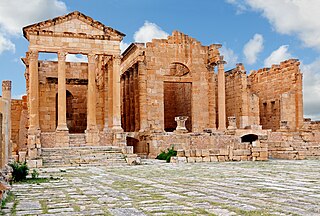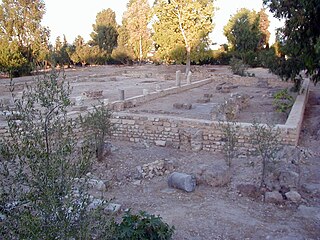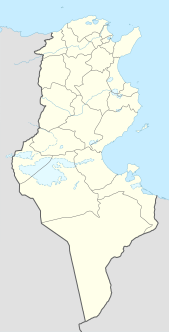
Donatism was a Christian sect leading to schism in the Roman Catholic Church, in the region of the Church of Carthage, from the fourth to the sixth centuries AD. Donatists argued that Christian clergy must be faultless for their ministry to be effective and their prayers and sacraments to be valid. Donatism had its roots in the long-established Christian community of the Roman Africa province in the persecutions of Christians under Diocletian. Named after the Berber Christian bishop Donatus Magnus, Donatism flourished during the fourth and fifth centuries.

Taparura was an ancient Berber, Punic and Roman city in the location of modern-day Sfax, Tunisia. It was a former Catholic diocese.

Djémila, formerly Cuicul, is a small mountain village in Algeria, near the northern coast east of Algiers, where some of the best preserved Roman ruins in North Africa are found. It is situated in the region bordering the Constantinois and Petite Kabylie.

Sbeitla or Sufetula is a small town in west-central Tunisia. Nearby are the Roman ruins of Sufetula, containing the best preserved Roman forum temples in Tunisia. It was the entry point of the Muslim conquest of North Africa.

Uppenna or Upenna is a Tunisian archaeological site located on the site of the present locality of Henchir Chigarnia. The site has delivered a basilica and the remains of a fortress.

Major religions practised in Gabon include Christianity, Islam, and traditional indigenous religious beliefs. Many people practice elements of both Christianity and traditional indigenous religious beliefs. Approximately 79 percent of the population practice one of the denominations of Christianity; 10 percent practice Islam ; the remainder practice traditional religion or other religions.
The Sfax Archaeological Museum is an archaeological museum located in Sfax, Tunisia.
Palladius was caesar of the Western Roman Empire for two months in 455, together with his father Petronius Maximus. He was born between 415 and 425 AD and may have held the position of Praetorian Prefect during the 450's. After his father, Petronius Maximus, assassinated Emperor Valentinian III and seized power, Palladius was elevated to caesar. He was married to Eudocia, to add to the legitimacy of his father's rule, however this broke the treaty made by Valentinian III and the Vandal king Genseric, in which they arranged the marriage of Eudocia to Huneric, Genseric's son. The Vandals invaded and sacked Rome, which led Petronius Maximus and Palladius to flee on 31 May 455, however, they were caught by a mob of peasants and killed, either by the mob themselves or palace servants.

Constantine the Great's (272–337) relationship with the four Bishops of Rome during his reign is an important component of the history of the Papacy, and more generally the history of the Catholic Church.

Quiza, which Pliny the Elder called Quiza Xenitana, was a Roman–Berber colonia, located in the former province of Mauretania Caesariensis. The town is identified with ruins at Sidi Bellater, Algiers.

The archaeological site of Sbeitla is an archaeological site in Sbeitla, in north-central Tunisia. It represents the Roman ruins of Sufetula, and contains the best preserved Roman forum temples in Tunisia. It was excavated and restored between 1906 and 1921.

The Archdiocese of Carthage, also known as the Church of Carthage, was a Latin Catholic diocese established in Carthage, Roman Empire, in the 2nd century. Agrippin was the first named bishop, around 230 AD. The temporal importance of the city of Carthage in the Roman Empire had previously been restored by Julius Caesar and Augustus. When Christianity became firmly established around the Roman province of Africa Proconsulare, Carthage became its natural ecclesiastical seat. Carthage subsequently exercised informal primacy as an archdiocese, being the most important center of Christianity in the whole of Roman Africa, corresponding to most of today's Mediterranean coast and inland of Northern Africa. As such, it enjoyed honorary title of patriarch as well as primate of Africa: Pope Leo I confirmed the primacy of the bishop of Carthage in 446: "Indeed, after the Roman Bishop, the leading Bishop and metropolitan for all Africa is the Bishop of Carthage."

Castellum Tingitii, also called Castellum Tingitanum, was a Roman colonia in Mauretania Caesariensis, and corresponds to present-day Chlef in Algeria.

Majorinus was the leader of a schismatic Christian sect in Roman North Africa known as the Donatists.
Felix, Bishop of Aptunga, in proconsular Africa was a 4th-century churchman, at the center of the Donatist controversy.
Maximian of Bagai was a 5th century bishop of Bagai in Roman North Africa. His life shows the extent that the religious schism in Roman North Africa could become violent.

Abthugni was an ancient city in Roman North Africa at present day Suwar (Henchir-es-Souar) in Tunisia. It was in Roman times in the province of Africa Proconsularis, Africa, and latter in Byzacena. In late antiquity Abthugni was also the seat of a bishop, and the diocese is a titular see of the Roman Catholic Church to this day.

Bagai was a Roman–Berber city in the province of Africa Proconsularis. It must have been of some reasonable size, as it was also the seat of an ancient Catholic bishopric. The ancient city has been identified with ruins at Ksar-Bagaï outside of Baghai, in the Aurès Mountains of the El Hamma District in Khenchela Province, Algeria.

Henchir-Khachoum is a locality and series of archaeological sites in Sidi Bouzid Governorate modern Tunisia. The ruins are strewn along a tributary of the Oued El Hatech river east of Sbeitla. During the Roman Empire there was a Roman town of the Roman province of Africa Proconsularis, called Muzuca, one of two North African towns to bare that name.

The Tébessa Basilica is a Late Roman archeological site located in the eastern Algerian city of Theveste, which is known today as Tébessa. It is one of the largest remains of Roman basilicas in Northern Africa. It was dedicated to St. Crispina to honor her martyrdom in 305 CE. This basilica was originally thought to have been created as a secular building for the Roman military; it developed into a religious building as new additions were built in the 4th and 5th century.



















